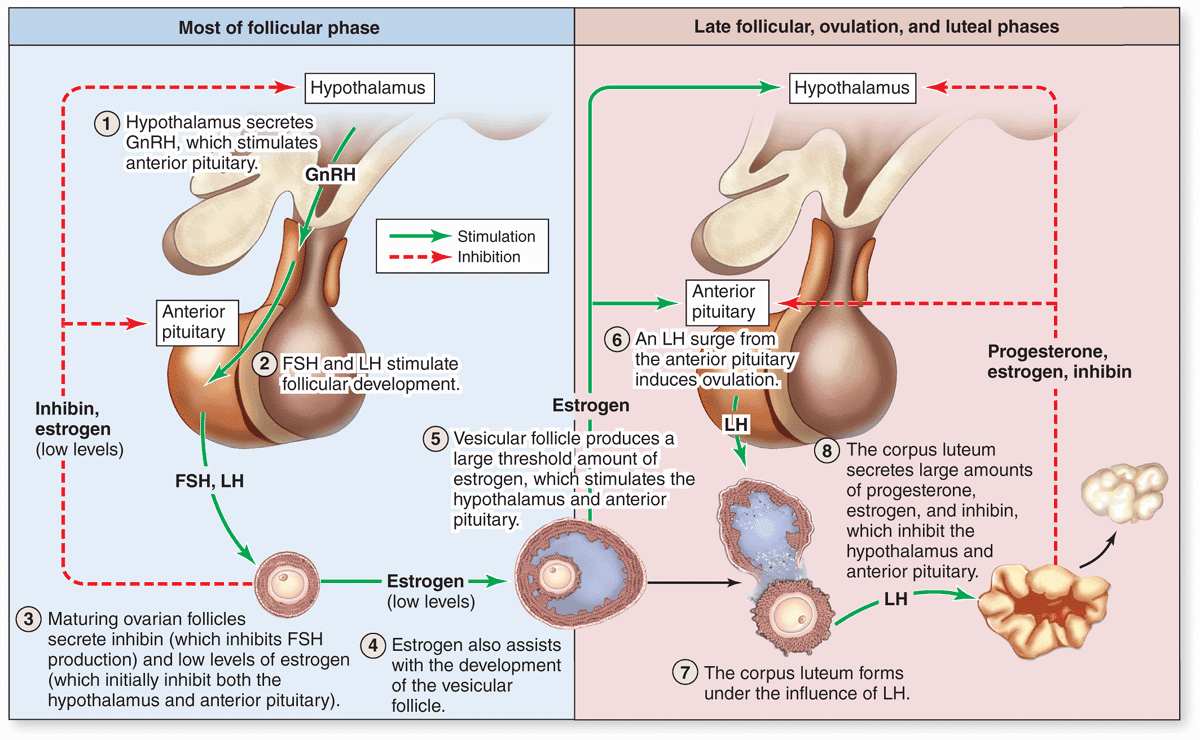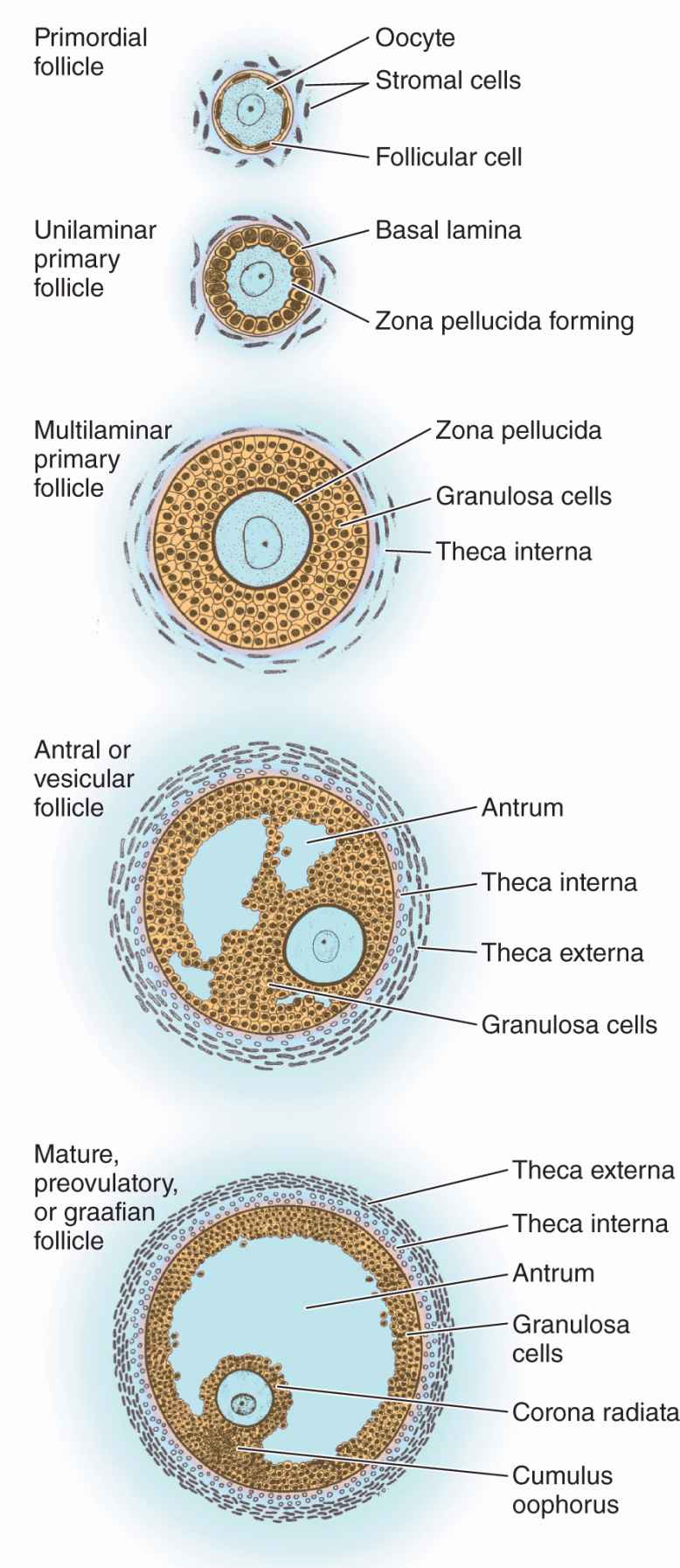Follicles in the Ovary That Are Never Ovulated
There are usually multiple follicles on each ovary. When the time comes and the follicle has grown to the right size it ruptures and releases a matured egg ready to be fertilised.

The Female Reproductive System Basicmedical Key
About 99 of ovarian follicles will disintegrate and never become mature enough to release an egg.

. Within the ovary there are hundreds of thousands of immature eggs inside structures called follicles that are never ovulated or fertilized. Follicular rupture was never observed when preovulatory rabbit follicles were isolated from the ovary before the ovulatory gonadotrophin discharge and placed in hormone-free culture for 10-14 h n 48. Follicles are found in your ovaries and at the beginning of each cycle a few of them begin to grow bigger.
The follicles that do not release a mature egg disintegrate a process known as atresia that can happen at any stage of follicular development. Become the corpus albicans. C degenerates into a zygote if.
The corpus luteum is a gland that A forms from a graafian follicle after ovulation. In stimulated cycle hormonal treatment generally all or most of the antral follicles grow. I went today hoping that Id have 2 follicles to trigger and that my uterine lining had increased.
Left ovary had a 10mm. PCOS can greatly interrupt the menstrual cycle causing irregular or even a complete lack of ovulation and so women with PCOS often have difficulties becoming pregnant. However if the follicles were taken 1 h post coitum and cultured under the same conditions 1124 458 ruptured spontaneously.
After ovulation the follicle. The follicles that do not release a mature egg disintegrate. Ovulation was never observed even in the presence of gonadotrophins when preovulatory follicles isolated from oestrous does were cultured in vitro n 112.
C form secondary follicles. The growth rate will be different for each of them. The number of oocytes reaches its maximum soon after the ovaries are formed.
Follicles in the ovary that are never ovulated Select one. Ovarian follicles are small fluid-filled sacs in your ovaries that each contain an unfertilized egg. Ovulation is all-or-none because follicle number before mating corresponds to corpora lutea CL number after coitus 14 CLovary.
Usually only 1 ovary grows a follicles large enough to contain a mature egg. However once in a while a woman will make 2 large follicles and if you ovulate both will be released. Attempts to replace the ovarian tissue by various steroid hormones or prostaglandins did not.
It is the only marker that can predict ovulation with ease. After spawning the ovary contained a few ripe oocytes that did not ovulate numerous primary growth oocytes including oocytes with cortical alveoli and postovulatory follicles. D undergo and complete meiosis in the ovary.
If the follicles were co-cultured with pieces of ovarian tissue and gonadotrophins then 50 ovulated P less than 001. This results in the 15 to 20 follicles staying inside the ovaries and they become cysts and it is these cysts that produce androgens. It has never happened that my follicles have gotten smaller.
That tends to happen in women as they get older or in younger women whose ovaries actually do not work as well. The Graafian follicle is the stage after the first meiotic division has completed but before ovulation. Left ovary had a 13 mm.
Follicles are small sacs of fluid found on the outside layer of the ovaries which contain immature eggs oocytes. Importance features to which attention has been directed are. Changes in the vascularization of the follicle the appearance of an avascular area known as the macula pellucida or stigma the formation of small blood clots near the stigma and some extravasation of blood.
While several follicles begin to develop each cycle normally only one will ovulate an egg. Before ovulation occurs the average diameter of the dominant follicle is 22 to 24 mm range 18-36 mm. After ovulation the follicle turns into a corpus luteum.
About 99 of ovarian follicles will disintegrate and never become mature enough to release an egg. Uterine lining 49mm right ovary had a 17 mm follicle and a 13 mm. Follicle growth and development are tracked during fertility treatments.
The follicle is characterized by a large follicular antrum that makes up most of the follicle. Even though one of the function of the ovary is to produce oocytes the majority of oocytes never ovulate. At birth a female has all the oocytes she will have in her life.
After that time oocyte number decreases dramatically. The secondary oocyte having undergone the first meiotic division is located eccentrically. This process occurs every menstrual cycle due to fluxes of hormones.
Today my lining was 9 mm right ovary had a 19mm follicle and a12mm. The oocyte is now a 2N haploid. In the ovaries of the female reproductive system an ovarian follicle is a fluid-filled sac that contains an immature egg or oocyte.
Follicles in the ovary that are never ovulated A degenerate. Youre born with a set number of eggs and ovarian follicles usually anywhere from 1 to 2 million and the total declines over time. No new oocytes are formed after birth.
B become the corpus albicans. A process known as atresia that can happen at any stage of follicular development. Polycystic ovarian syndrome PCOS is a condition which affects how the ovaries work.
It usually means cysts can be seen on the ovaries or high levels of male hormones in the body can prevent the ovary from releasing an egg. The germinal epithelium was active in postspawned rainbow trout as determined by the presence of numerous cell nests composed of oogonia mitotic oogonia early diplotene oocytes and prefollicle cells. The appearance of mammalian follicles at the time of ovulation has been described by numerous observers.
A common misconception is that each follicle releases multiple eggs. If mating is limited to one copulation neither an LH surge nor ovulation usually occurs. They each contain and nurture a potential egg but only one follicle outgrows the rest and manages to release the egg during ovulation.

The Female Reproductive System Basicmedical Key

Pcos How It Works Pcos Polycystic Ovary Syndrome Polycystic Ovaries

Comments
Post a Comment